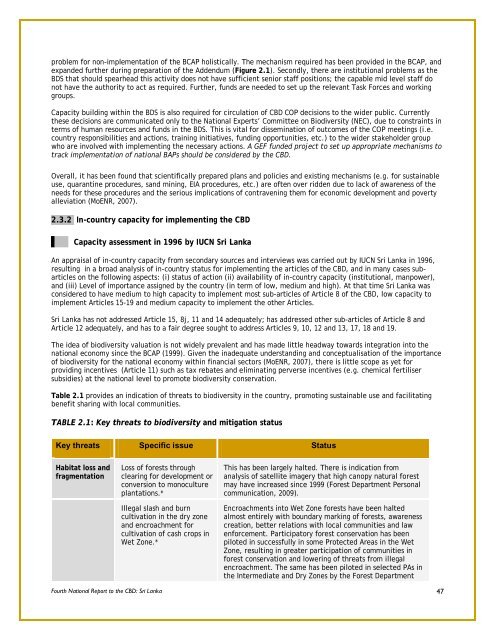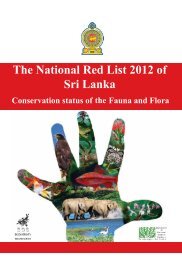English - Convention on Biological Diversity
English - Convention on Biological Diversity
English - Convention on Biological Diversity
You also want an ePaper? Increase the reach of your titles
YUMPU automatically turns print PDFs into web optimized ePapers that Google loves.
problem for n<strong>on</strong>-implementati<strong>on</strong> of the BCAP holistically. The mechanism required has been provided in the BCAP, andexpanded further during preparati<strong>on</strong> of the Addendum (Figure 2.1). Sec<strong>on</strong>dly, there are instituti<strong>on</strong>al problems as theBDS that should spearhead this activity does not have sufficient senior staff positi<strong>on</strong>s; the capable mid level staff d<strong>on</strong>ot have the authority to act as required. Further, funds are needed to set up the relevant Task Forces and workinggroups.Capacity building within the BDS is also required for circulati<strong>on</strong> of CBD COP decisi<strong>on</strong>s to the wider public. Currentlythese decisi<strong>on</strong>s are communicated <strong>on</strong>ly to the Nati<strong>on</strong>al Experts’ Committee <strong>on</strong> Biodiversity (NEC), due to c<strong>on</strong>straints interms of human resources and funds in the BDS. This is vital for disseminati<strong>on</strong> of outcomes of the COP meetings (i.e.country resp<strong>on</strong>sibilities and acti<strong>on</strong>s, training initiatives, funding opportunities, etc.) to the wider stakeholder groupwho are involved with implementing the necessary acti<strong>on</strong>s. A GEF funded project to set up appropriate mechanisms totrack implementati<strong>on</strong> of nati<strong>on</strong>al BAPs should be c<strong>on</strong>sidered by the CBD.Overall, it has been found that scientifically prepared plans and policies and existing mechanisms (e.g. for sustainableuse, quarantine procedures, sand mining, EIA procedures, etc.) are often over ridden due to lack of awareness of theneeds for these procedures and the serious implicati<strong>on</strong>s of c<strong>on</strong>travening them for ec<strong>on</strong>omic development and povertyalleviati<strong>on</strong> (MoENR, 2007).2.3.2 In-country capacity for implementing the CBD.2.1 Capacity assessment in 1996 by IUCN Sri LankaAn appraisal of in-country capacity from sec<strong>on</strong>dary sources and interviews was carried out by IUCN Sri Lanka in 1996,resulting in a broad analysis of in-country status for implementing the articles of the CBD, and in many cases subarticles<strong>on</strong> the following aspects: (i) status of acti<strong>on</strong> (ii) availability of in-country capacity (instituti<strong>on</strong>al, manpower),and (iii) Level of importance assigned by the country (in term of low, medium and high). At that time Sri Lanka wasc<strong>on</strong>sidered to have medium to high capacity to implement most sub-articles of Article 8 of the CBD, low capacity toimplement Articles 15-19 and medium capacity to implement the other Articles.Sri Lanka has not addressed Article 15, 8j, 11 and 14 adequately; has addressed other sub-articles of Article 8 andArticle 12 adequately, and has to a fair degree sought to address Articles 9, 10, 12 and 13, 17, 18 and 19.The idea of biodiversity valuati<strong>on</strong> is not widely prevalent and has made little headway towards integrati<strong>on</strong> into thenati<strong>on</strong>al ec<strong>on</strong>omy since the BCAP (1999). Given the inadequate understanding and c<strong>on</strong>ceptualisati<strong>on</strong> of the importanceof biodiversity for the nati<strong>on</strong>al ec<strong>on</strong>omy within financial sectors (MoENR, 2007), there is little scope as yet forproviding incentives (Article 11) such as tax rebates and eliminating perverse incentives (e.g. chemical fertilisersubsidies) at the nati<strong>on</strong>al level to promote biodiversity c<strong>on</strong>servati<strong>on</strong>.Table 2.1 provides an indicati<strong>on</strong> of threats to biodiversity in the country, promoting sustainable use and facilitatingbenefit sharing with local communities.TABLE 2.1: Key threats to biodiversity and mitigati<strong>on</strong> statusKey threats Specific issue StatusHabitat loss andfragmentati<strong>on</strong>Loss of forests throughclearing for development orc<strong>on</strong>versi<strong>on</strong> to m<strong>on</strong>ocultureplantati<strong>on</strong>s.*Illegal slash and burncultivati<strong>on</strong> in the dry z<strong>on</strong>eand encroachment forcultivati<strong>on</strong> of cash crops inWet Z<strong>on</strong>e.*This has been largely halted. There is indicati<strong>on</strong> fromanalysis of satellite imagery that high canopy natural forestmay have increased since 1999 (Forest Department Pers<strong>on</strong>alcommunicati<strong>on</strong>, 2009).Encroachments into Wet Z<strong>on</strong>e forests have been haltedalmost entirely with boundary marking of forests, awarenesscreati<strong>on</strong>, better relati<strong>on</strong>s with local communities and lawenforcement. Participatory forest c<strong>on</strong>servati<strong>on</strong> has beenpiloted in successfully in some Protected Areas in the WetZ<strong>on</strong>e, resulting in greater participati<strong>on</strong> of communities inforest c<strong>on</strong>servati<strong>on</strong> and lowering of threats from illegalencroachment. The same has been piloted in selected PAs inthe Intermediate and Dry Z<strong>on</strong>es by the Forest DepartmentFourth Nati<strong>on</strong>al Report to the CBD: Sri Lanka 47














